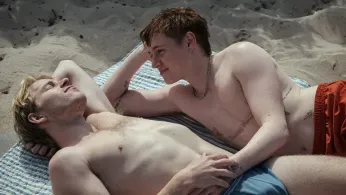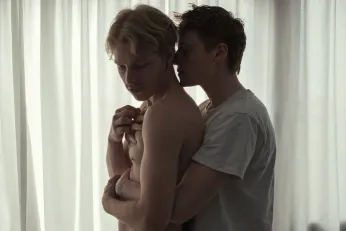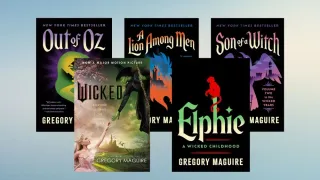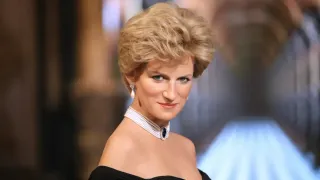
3 hours ago
EDGE Interview: A Queer Love Story Like No Other - Director Mathias Broe Redefines Danish Cinema With ‘Sauna’
Steve Duffy READ TIME: 2 MIN.
Sauna, the highly anticipated debut feature from director Mathias Broe, and the first film in Denmark to cast a transgender actor in a leading trans role, released worldwide on November 18. Based on the acclaimed book by writer and activist Mads Ananda Lodahl, the film is an intimate reimagining of Romeo and Juliet that explores love, belonging, and identity within Copenhagen’s queer community. At its center is the story of Johan, a gay man longing for intimacy and connection, and William, a trans man stepping into his gender transition. Their relationship begins with a Grindr hookup and grows into a bond that both heals and tests them, unfolding in the charged space of the gay sauna. “I had never seen a love story between a trans gay man and a cis gay man before,” says Broe. “So I was really excited to bring new perspectives to queer cinema. I understood both characters on a deep emotional level, and the story depicts so many of the questions you face as an LGBTQ+ person.” Broe drew inspiration not only from Lodahl’s book but from his own life. “I’ve been wanting to make a film from my own queer community in Copenhagen for a long time,” he explains. “When the love story about William and Johan was presented to me, it was the perfect opportunity to realize that dream. It’s also a very personal story to me, since my own partner started transitioning while making Sauna.” The film also interrogates norms within the LGBTQ+ community itself. “The LGBTQ+ community is not a big happy family,” Broe notes. “There’s a lot of prejudice even within the queer community. Hopefully, Sauna will dismantle some of those ideas and limitations we put on each other and make people reflect on the script we’re all forced to follow.”
With Sauna now poised to make its mark, Broe reflects on the experiences, influences, and personal revelations that shaped both the film and his path as a filmmaker.

Source: Nordisk
EDGE: How did you get into filmmaking?
MB: Yes. I’ve always been a very visual person. I grew up in the countryside, where there wasn’t much to do, so I often had to rely on my imagination. There are many reasons why I became a filmmaker, but three stand out to me. I grew up with a father who was an alcoholic. That experience made me very attuned to spaces and moods. If I wanted to invite a friend over, I had to sense the atmosphere—was he drunk, was the tension high? I became what you might call a “satellite child,” someone who picks up on the energy in a room. That skill has deeply influenced my filmmaking because creating atmosphere and sensing space is something I’m naturally good at. I was a professional dancer for many years. Dance—especially ballroom—is all about discipline, rhythm, and aesthetics. From a young age, I was taught to think in images and translate them into physical movement. That connection between imagery and expression shaped the way I approach visual storytelling as a director. Being queer has also shaped my perspective. Growing up, I often felt a sense of alienation—not that I didn’t fit in, but that something else was waiting for me. Film became a way to escape the ordinary and explore worlds beyond reality. That feeling of searching for something more has always driven my creative vision. So, those three experiences—my upbringing, my dance career, and my identity—are the core reasons why I became a filmmaker.
EDGE: Sauna is your feature debut. What drew you to this story?
MB: I’ve had the ambition to tell a queer story for a long time. During film school, I created my graduation film, Super 16, which explored themes of sexuality, identity, and masculinity. Later, I became deeply drawn to Sauna because I fell in love with its characters. The film is based on a book of the same name, and when I read it, I found the characters incredibly original. It felt like a queer love story I hadn’t seen before, which was very intriguing to me. At the same time, I wanted to portray the queer community I’m part of in Copenhagen—the way I experience it in my own life. Working on a story that fascinated me while reflecting my reality was a unique challenge. And as the film developed, it became even more personal: my own partner began transitioning during the process. So what started as an adaptation gradually evolved into a deeply personal story.
EDGE: You’ve mentioned that your partner began transitioning during the film’s development. How did that personal experience shape your directorial approach?
MB: I felt I needed to put more of myself into the story, which was a rewarding process because I could draw from my own experiences and personal relationship. The feelings Johann, the main character, has—like not feeling welcome in a space or being unsure if he’s speaking the right language—are emotions I’ve definitely felt myself. When my partner began transitioning, it was a difficult period for both of us. Suddenly, I had to acknowledge that her reality and development were different from mine. Before that, I think I had been searching for someone who was almost a mirror of myself. For many queer people—especially those who grow up outside big cities—there’s a deep sense of loneliness. So when we look for love, we often unconsciously seek someone who reflects us. This experience became a journey of maturity for me: learning to separate my identity from my partner’s. That realization ultimately shaped one of the film's central themes.

Source: Nordisk
EDGE: What were the biggest challenges in translating such intimate and complex themes to the screen?
MB: Yes, because when you make cinema—especially in Denmark, where this is a Danish film and we’re only about six million people—the queer community is significant, but it’s not huge. That creates a challenge: you need to make a film that resonates with the community while also being accessible to an audience that may not know much about it.We made a conscious choice: first and foremost, this film is for queer audiences. That means we can’t talk down to them. We have to be authentic and do thorough research so they can relate to the complexity of the story. At the same time, we want to build a bridge to the broader audience. So we include enough context for people to understand what we’re exploring—while respecting that audiences are often more intelligent than you think. It’s always a challenge because filmmaking is expensive. You want to sell tickets, and you want to prove that queer films don’t have to remain niche or small. They can succeed commercially and reach a wider audience.
EDGE: Can you talk about the casting process, especially finding Denmark’s first trans lead, Nina Rask, for the role of William?
MB: It was really important to give transmasculine actors a chance because there have been almost no roles for trans men in Denmark—essentially none. So we made a conscious effort to open up the casting process and search across the entire country. In the end, about 45 trans men came in to audition, and we tried out a lot of different approaches. Ultimately, Nina was the best fit for the role. Nina is quite well-known in Denmark and represents a new generation’s perspective on gender, body, and sexuality. She previously acted in the series Sex, where she didn’t play a transmasculine character. Nina uses all pronouns, which is why I refer to her as “she.” What mattered most for us was capturing William’s complexity—he’s a character who protects himself because he’s searching for his identity. He wants permission to be who he truly is, and that makes him guarded. To make the love story believable, we needed an actor who could contrast that guardedness and help us understand why Johan would fall in love with William, despite his cynicism and coldness. Nina brought that contrast beautifully. She’s incredible at improvisation, and because she’s trans herself, she understands the nuances of the experience. That made it easier for her to step into William’s journey and navigate the big emotional conflicts. One of the most powerful moments came during an improvised line in a breakup scene: she said, “Why do you blame me? I think you feel lonely wherever you are.” That wasn’t in the script, but it was so precise and revealing about Johan’s character. Nina has this rare ability to be fully present and deeply connected to the situation, which made the performance extraordinary.
EDGE: What was your favorite part of making Sauna?
MB: I have some scenes that I’m really proud of and truly love. From a director’s perspective, one of the most incredible experiences was shooting the big party scenes. The entire Copenhagen queer community came together to be part of the film, which meant so much to us. It was important that people felt included and that we represented the community authentically. I’ll never forget arriving on set at eight in the morning and seeing 250 queer people show up—simply because they were excited about the project. It was both touching and beautiful. And of course, making your first feature film is always a huge milestone. To have the opportunity to create portraits of a community and the characters I deeply care about—people who reflect my everyday life—has been an amazing experience.

Source: Nordisk
EDGE: How do you see Sauna contributing to the legacy of queer cinema in Denmark and internationally?
MB: One of the most exciting things has been seeing how well the film resonates internationally. We were just in China—where the film can’t be shown publicly and conversations about it are limited—but even there, the themes felt universal. The experiences and interests of queer people across the world share so many similarities, and that has been deeply moving to witness. Although this is a Danish film, it has already sold to the U.S., premiered at Sundance, and will be in cinemas starting November 18. It’s incredible to see that a story rooted in Copenhagen can connect with audiences on the other side of the planet. That’s what I hope the film contributes to: showing different aspects of queer lives from different parts of the world and proving that there is an audience for these stories. This is especially important in Denmark, where selling a film like this is a real challenge. We did well in cinemas, but it’s still hard to convince investors that queer films can travel. So I’m proud that we’ve shown it’s possible—that even a film that seems small on paper in Denmark can become a big film internationally because it resonates beyond borders.
EDGE: What do you love about the queer community in Denmark?
MB: It’s not the biggest community, but that’s part of what makes it feel like home. I’m lucky to have a strong, politically engaged community here—people who genuinely care for one another. We have so many iconic figures who work hard to make the nightlife vibrant and create initiatives that bring people together. Copenhagen has a very strong cis-queer scene and also a thriving, more fluid queer scene. It’s important for these spaces to connect and overlap more. I also think the lesbian community in Copenhagen deserves more dedicated spaces. Hopefully, we can keep supporting each other and creating environments where everyone feels welcome and can have a great time.
EDGE: What stories are you interested in telling next?
MB: I’m currently working on a project about Herman Bang, who was the first publicly gay famous person in Denmark. He was an iconic writer in the 1800s. My hope is to create a biopic about him—a love story and a portrait of what it was like to grow up queer in Denmark.
Sauna is now available to rent or own on all major digital platforms.






